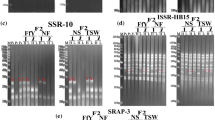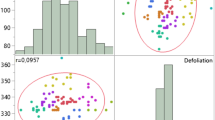Abstract
White clover (Trifolium repens L.) is a perennial legume with various traits; it grows in temperate regions and has high potential as an ornamental plant. In the present study, four parental varieties (Ladino, Green Ice, William, and Dragon’s Blood) of white clover were classified based on 11 morphological traits [plant form, leaf shape, leaf edge shape, upper lamina color, lower lamina color, white V mark, midrib color, leaf patterns (front and back), flower color, and peduncle color]. Based on these traits, two hybrids were selected as follows: Ladino × Green Ice [hereafter referred to as Jeju Hapiness-1 (JH-1)] and William × Dragon’s Blood (JH-5). In addition, random amplified polymorphic DNA (RAPD) analysis was performed to confirm the molecular biological relationship between the parental varieties and hybrids. We confirmed to contain the polymorphic bands of the parental varieties at OPC13, OPD6, and OPG4 operon primers from JH-1, and at OPE10, OPG12, and OPH11 from JH-5. Further, the RAPD patterns from the hybrids were compared with the four parental varieties. A distinguishable RAPD pattern was identified in OPC13 and OPG4 from JH-1 and in OPG12 and OPH11 from JH-5. In addition, polymorphic DNA fragments in which the genetic relationship between the parental varieties and hybrids was confirmed were converted into sequence characterized amplified region (SCAR) markers. The morphological classification criteria, RAPD pattern, and SCAR marker are all considered useful for the classification and breeding of white clover and protecting varieties developed.




Similar content being viewed by others
Data availability
The data that support the finding of this study are available from the corresponding author upon reasonable requests.
References
Ballizany W, Hofmann R, Jahufer M, Barrett B (2014) Variation for constitutive flavonols and morphological traits in a new white clover population. Environ Exp Bot 105:65–69
Bernet GP, Bramardi S, Carbonell EA, Asins MJ (2003) Applicability of molecular markers in the context of protection of new varieties of cucumber. Plant Breeding 122:146–152
Bortolini F, Agnol MD, Schifino-Wittmann MT (2006) Molecular characterization of the USDA white clover (Trifolium repens L) core collection by RAPD markers. Genet Resour Crop Evol 53:1081–1087
Brewbaker J (1955) V-leaf markings of white clover. J Hered 46(3):115–123
Caradus JR (1986) World checklist of white clover varieties. N.Z. J Agric Res 14(2):119–164
Cho KH, Heo S, Kin HR, Kim JH, Shin IS, Han SE, Kim SH, Kim DH (2010) Discrimination of Korean apple cultivars using combination of RAPD-SCAR markers. Kor J Hort Sci Technol 28(5):828–835
Cho KH, Cho KS, Han JH, Kim HR, Shin IS, Kim SH, Chun JA, Hwang HS (2013) Development of sequence characterized amplified region markers for cultivar identification in persimmon. Kor J Hort Sci Technol 31(6):798–806
Chung SJ, Park SU, Kim HJ, Yang GM, Choi JS, Oh CJ, Jang DH, Song IJ, Lee GJ (2013) RAPD-SCAR markers linked to medium-leaf zoysiagrass ecotypes. Weed Turf Sci 2(2):191–197
Corkill L (1971) Leaf marking in white clover. J Hered 62(5):307–310
Frame J, Newbould P (1986) Agronomy of white clover. Adv Agron 40:1–88
Gibson PB, Cope WA (1985) White Clover. Clover science and technology. Madison, WI, pp 471–490
Griffiths AG, Moraga R, Tausen M, Gupta V, Bilton TP, Campbell MA, Ashby R, Nagy I, Khan A, Larking A, Anderson C, Franzmayr B, Hancock K, Scott A, Ellison NW, Cox MP, Asp T, Mailund T, Schierup MH, Andersen SU (2019) Breaking free: the genomics of allopolyploidy-facilitated Niche expansion in white clover. Plant Cell 31:1466–1487
Gustine DL, Voigt PW, Brmmer E, Papadopoulos YA (2002) Genetic variation of RAPD markers for North American white clover collections and cultivars. Crop Sci 42:343–347
Han HS, Jung JS (2021) Development of a female-associated SCAR marker in Schisandra nigra max. J Life Sci 31(6):537–542
Helgadóttir Á, Dalmannsdóttir S, Collins RP (2001) Adaptational changes in white clover populations selected under marginal conditions. Ann Bot 88(1):771–780
Hong YP, Lee JW (2016) Development of SCAR marker for identifying male trees of Ginkgo biloba using multiplex PCR. J Korean for Soc 105(4):422–428
Huang SC, Tsai CC, Sheu CS (2000) Genetic analysis of Chrysanthemum hybrids based on RAPD molecular markers. Bot Bull Acad Sin 41:257–262
Jones ES, Hughes LF, Drayton MC, Abberton MT, Michaelson-Yeast TPT, Bowen C, Forster JW (2003) An SSR and AFLP molecular marker-based genetic map of white clover (Trifolium repens L.). Plant Sci 165:531–539
Joung YH, Kim ST, Kim GJ, Lee JH, Gi GY, Han TH (2010) Genetic relationship of genus Rosa Germplasm and genetic diversity of Rosa rugosa in Korea. Kor J Hort Sci Technol 28(6):1003–1013
Khanlou KM, Vandepitte K, Asl LK, Bockstaele EV (2011) Towards an optimal sampling strategy for assessing genetic variation within and among white clover (Trifolium repens L) cultivars using AFLP. Genet Mol Biol 34(2):252–258
Lee SB, Kim CK, Oh JY, Kim KM (2011) Classification of Allium monanthum and A. grai by ISSR markers. Kor J Hort Sci Technol 29(6):600–609
Ma S, Han C, Zhou J, Hu R, Jiang X, Wu F, Ke T, Nie G, Zhant X (2020) Fingerprint identification of white clover cultivars based on SSR molecular markers. Mol Biol Rep 47:8513–8521
Paran I, Michelmore RW (1993) Development of reliable PCR-based markers linked to downy mildew resistance genes in lettuce. Theor Appl Genet 85:985–993
Porebski S, Bailey LG, Baum BR (1997) Modification of a CTAB DNA extraction protocol for plants containing high polysaccharide and polyphenol components. Plant Mol Biol Rep 15:8–15
Rebecca MT, Han YH, Maria JM, Joseph HB, Wayne AP (2010) Leaf trait coloration in white clover and molecular mapping of the red midrib and leaflet number traits. Crop Sci 50(4):1260–1268
Till I (1987) Variability of expression of cyanogenesis in white clover. Heredity (edinb) 59:265–271
William JGK, Kubelik AR, Livak KJ, Rafalski JA, Tingey SV (1990) DNA polymorphisms amplified by arbitrary primers are useful as genetic markers. Nucleic Acids Res 18(22):6531–6535
Zhang Y, Sledge MK, Bouton JH (2007) Genome mapping of white clover (Trifolium repens L.) and comparative analysis within the trifolieae using cross-species SSR markers. Theor Appl Genet 114:1367–1378
Zhang H, Tian H, Chen M, Xiong J, Cai H, Liu Y (2018) Transcriptome analysis reveals potential genes involved in flower pigmentation in a red-flowered mutant of white clover (Trifolium repens L.). Genomics 110:191–200
Acknowledgements
This research was funded by the Basic Science Research Program through the National Research Foundation of Korea (grant numbers: 2019R1A6A1A11052070 and 2020R1I1A1A01063379).
Author information
Authors and Affiliations
Corresponding authors
Additional information
Publisher's Note
Springer Nature remains neutral with regard to jurisdictional claims in published maps and institutional affiliations.
Supplementary Information
Below is the link to the electronic supplementary material.
Rights and permissions
Springer Nature or its licensor (e.g. a society or other partner) holds exclusive rights to this article under a publishing agreement with the author(s) or other rightsholder(s); author self-archiving of the accepted manuscript version of this article is solely governed by the terms of such publishing agreement and applicable law.
About this article
Cite this article
Han, S.S., Sun, H.J., Eun, C.H. et al. Morphological classification and molecular marker development of white clover (Trifolium repens L.) parents and hybrids. Plant Biotechnol Rep 16, 721–728 (2022). https://doi.org/10.1007/s11816-022-00803-8
Received:
Revised:
Accepted:
Published:
Issue Date:
DOI: https://doi.org/10.1007/s11816-022-00803-8




